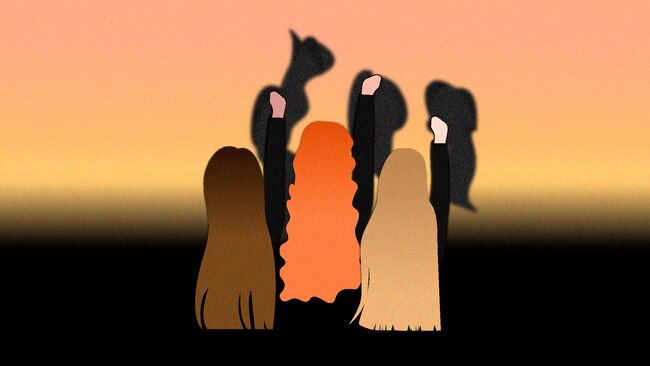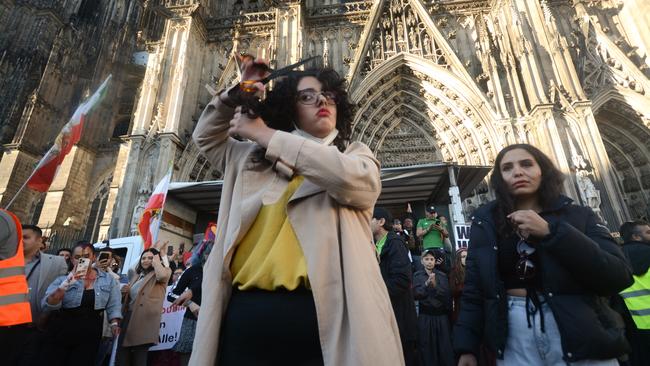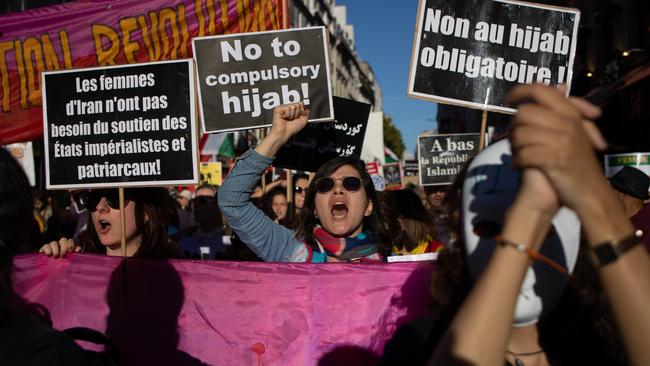Gen Z becomes the Iranian regime's fiercest opponent
Young Iranian women have been the driving force behind what could be the toppling of the country's strict regime.

Young Iranian women have been the driving force behind what could be the toppling of the country's strict regime.
Iranian schoolgirls on Monday stuck up their middle fingers at an image of the Islamic republic president, as the country's violent protests enter their fourth week.
The teenagers dangled their headscarves in the air yelling “freedom, freedom”, and ran from police trying desperately to reprimand them.
University students painted their hands in mock blood, and sawed off their hair to the cheers of their peers. They screamed and chanted the names of their friends who have died in the vicious and often violent battle against the regime that governs them.
Following the death of 22 year old Mahsa Amini at the hands of the notorious Tehran morality police on September 16, a new enemy has arisen as a sturdy opponent to the Islamic Republic.
Gen Z women.

“When I grew up in Iran, I was isolated and terrified. There was no internet for us to learn new methods of resistance,” Saba Vasefi, an Iranian-Australian scholar who fled the country in 2009 to become an academic at The University of Sydney.
“But the age of resistance has been reduced to much younger generations now. And they are living in a cyber space on social media which reveals to them what they’re missing out on, from people living over the other side of the world.
“They know what they don’t have, and they’re fighting for it.”
Students at Azad University in Sohanak stage a performance to protest against the murders committed by the Islamic Republic regime. #Tehran , Oct 09, 22. #IranProtests2022 #MahsaAmini #Mahsa_Amini‌ pic.twitter.com/earb1tFSgC
— IranWire (@IranWireEnglish) October 9, 2022
Protesters were enraged after Amini died in custody on September 16 after being detained for allegedly violating the country's strict Islamic hijab rules.
For weeks they have remained defiant, with students staging sit-ins and some industrial workers going on strike despite a government crackdown leaving dozens dead and hundreds more imprisoned. Videos posted on social media indicated that protests flared at various points in the capital and other cities over recent days, with women burning headscarves, cutting their hair and shouting slogans against the Islamic republic.
While decades of female protestors before these have desperately tried to achieve reform for the Sharia Law that governs what they wear, how they act and where they go, these women are different. They say they are not going to give up until the regime is overthrown and lasting change is achieved.
I’m running out of words to describe my astonishment. Just over 3 weeks after #MahsaAmini’s death, women are defiantly walking on the streets of #Tehran, with no hijab…while cars are honking in their supports. Mahsa couldn’t have imagined how she changed life for many Iranians. pic.twitter.com/o6zRJn06WP
— Rana Rahimpour (@ranarahimpour) October 9, 2022
“We are not calling this an uprising, it’s a revolution, and the revolution has come in three stages,” Dr Vasefi said.
“The first stage was anger, rage, provocation displayed in these young women cutting off their hair and storming the streets. The second stage was the university students and the high school students fighting back against the government.
“And in this third stage we are seeing diverse people - LGBTQI people, people with disability, traditional muslim women, Turks, Kurdish people - joining together to overthrow the regime.”
Students at the Amir Kabir University of Technology chant “Poverty, corruption and injustice!
— Saba Vasefi ♀ (@SabaVasefi) October 10, 2022
Death to tyranny!â€#MahsaAmini#IranRevolution2022#مهسا_امینی pic.twitter.com/4W0dfv0JPh
The use of social media amongst young protesters has helped spread the message of the cause around the world, with rallies erupting in Italy, France and Germany.

The crackdown on the protests sparked by Amini’s death has claimed at least 95 lives according to Iranian Human Rights.
Another 90 people were killed by the security forces in Iran’s far southeastern city of Zahedan from September 30 after protests sparked by the alleged rape of a teenage girl by a police chief in the Sistan-Baluchistan province, said IHR, citing the UK-based Baluch Activists Campaign.
State media have said 24 members of the security forces have been killed overall, including in the Zahedan unrest.
With AFP



